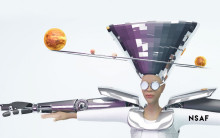Happenings from the Shapiro Design Lab.
Lab Notes

Posts in Lab Notes
Showing 161 - 170 of 234 items
•
- Lovejeet Gehlot
Have you ever wondered how does google 3D map work? Or, have you ever observed 3D objects in games or movies that look so real, it is impossible for you to believe that it was modeled and rendered artificially?
Well, the answer might be Photogrammetry. Photogrammetry is often defined as the science of taking measurements from photographs. In a simpler term, you can scan an object and create your own 3D model through a free software just by taking a few overlapping pictures of the model. Need fancy cameras? No. You can even use your cellphone camera and take some pictures by hand. Benefit of using photogrammetry over laser scanning is that photogrammetry can provide a vrml file format, that means that it would also include the surface colors of the scanned object. Whereas, laser scanning fails to capture the colors of the surfaces and can only provide an stl file with no color data.
Well, the answer might be Photogrammetry. Photogrammetry is often defined as the science of taking measurements from photographs. In a simpler term, you can scan an object and create your own 3D model through a free software just by taking a few overlapping pictures of the model. Need fancy cameras? No. You can even use your cellphone camera and take some pictures by hand. Benefit of using photogrammetry over laser scanning is that photogrammetry can provide a vrml file format, that means that it would also include the surface colors of the scanned object. Whereas, laser scanning fails to capture the colors of the surfaces and can only provide an stl file with no color data.
•
- Kayla Williams
I have always been curious and interested in Project Management. The most I knew about it was from observing my Product Owner during my summer internship. Product Owner is somewhat similar to a Project Manager for Agile Methodology in a work environment. I witnessed my PO managing meetings and being a form of communication. It seems as if a PO presents information and reports back to the higher up. But I haven’t gotten a strong understanding of their role especially behind the scenes. So, out of curiosity, I decided to watch Project Management Foundations on Lynda.
•
- Daniel Schorin
When the microprocessor was invented in 1972, the US economic productivity was at a 40 year low. Computers became popular in businesses and homes in following years, and what came next radicalized the economy and business forever. Computers allowed businesses newfound abilities for number crunching, data saving, and word documentation.
While computers are revolutionary in their ability to compute repetitive calculations and follow complex programmed instructions, they have never been sufficient at pattern recognition. This makes image and speech recognition extraordinarily difficult for ordinary computers, which is why it took until 2018 to unlock your iPhone using your face and why telephone chatbots are so frustratingly stupid.
While computers are revolutionary in their ability to compute repetitive calculations and follow complex programmed instructions, they have never been sufficient at pattern recognition. This makes image and speech recognition extraordinarily difficult for ordinary computers, which is why it took until 2018 to unlock your iPhone using your face and why telephone chatbots are so frustratingly stupid.
•
- Connor Lockman
Machine learning has changed, and will continue to change the world around us. Over the course of November, I spent time completing an online Lynda course titled, Deep Learning: Image Recognition by Adam Geitgey. In this course, I learned key concepts about neural networks and built on what I learned in last month’s machine learning course. By the end of this course, I was able to get a toy neural network working and understanding, at a basic level, the different components that play a part in making it function.
•
- Hallee Thompson
During my time at the Design Lab, I have been interested in how our work in Open Accessibility can help future students on campus. For example, in the lab we are currently developing tactile maps of the library for the visually impaired. A long-term goal of ours is to, not only produce maps for our university, but to create a workflow so that our research can help other universities do the same.
•
- Bruna Carolina Iunessanches
As a resident of Open Accessibility here at the Design Lab, I am interested not only in how to make spaces and resources more accessible at our school with the projects I work on, but also how to create workflows for other people – and other schools – to easily follow and do the same for their spaces and resources. The more automated things are, the easier it is for people follow it and do it themselves, especially those who may not have experience or simply do not have the time. So the best way, in my opinion, to bring open accessibility options to the public, is to automate as much of it as possible.
•
- Michael Cory Lenard
Coming into the Citizen Science arm of the Design Lab, I knew I had decent knowledge of one aspect of the activity: the science part. Having extensive education in scientific fields means that I generally understand what the strengths and weaknesses of science are, what a good data collection protocol looks like, and the sorts of things it can tell us about our world. What I joined knowing quite a bit less about was the “people” aspect of citizen science: the part where we have to engage people and communities to demonstrate how these activities can be beneficial, informative, effective and fun for them as well. One of the things that has allowed me to understand the people aspect of citizen science better was the Rackham DEI workshop on Entering Communities.
•
- Kayla Williams
Aimi Hamraie visited University of Michigan, as a part of Disability Awareness Month, and shared her well-known book as Building Access: Universal Design and the Politics of Disability. Hamraie shared key points from her book such as strategies for designing and making things more accessible for those with disabilities. She shared history from the time people have been advocating for rights and accessibility to now. Lastly, she discussed her remarkable work at Vanderbilt University with an ongoing project revolving around participatory mapping, data collection, and Crip technoscience project that are based on principles of disability justice, intersectionality, and spatial practice to explore mapping as a tool for social justice.

- Hallee Thompson
When approaching projects on accessibility, I first wanted to understand my community. Who I am designing for? What goals am I trying to achieve? With these questions in mind, I chose to focus my attention on diversity in technology. More people are using technology than ever before. How can we then use technology as a tool to, not only acknowledge, but improve the lives of the diverse groups of people within our communities? The Michigan Meetings Fall Symposium took a closer look into these questions.
•
- Justin Schell
The Shapiro Design Lab seeks undergraduate students to become Audio Interns for the upcoming semester, to help develop the Lab's programs in audio production and post-production.